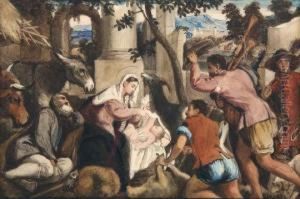Louisa Lady Waterford Paintings
Louisa Anne Beresford, Marchioness of Waterford, commonly known as Lady Waterford, was a British artist and philanthropist born on April 14, 1818, in Paris, France. She was a prominent figure in the Pre-Raphaelite movement, known for her watercolor paintings and her involvement in various charitable endeavors. Lady Waterford was also associated with the broader circle of Victorian artists and intellectuals, including John Ruskin and the members of the Pre-Raphaelite Brotherhood. Her work often reflected her deep Christian faith and her interest in subjects drawn from literature, history, and the Bible.
Lady Waterford was born into the aristocratic Stuart family, the daughter of Charles Stuart, who served as a British diplomat, and Louisa Bertie. Her upbringing and marriage into the Waterford family, one of the leading Anglo-Irish families, provided her with the social platform and resources to pursue her artistic and philanthropic interests. In 1842, she married Henry Beresford, 3rd Marquess of Waterford, becoming Marchioness of Waterford. Although her marriage was childless and marked by the early death of her husband in 1859, it significantly influenced her life and work, leading her to spend much of her time in Ireland and England.
After her husband's death, Lady Waterford dedicated herself more fully to her art and philanthropy. She became deeply involved in designing and decorating the school at Ford, Northumberland, showcasing her commitment to education and the welfare of the local community. Her artistic style was characterized by its detailed depiction of figures, rich color palette, and incorporation of religious and moral themes. Despite her talents, Lady Waterford was modest about her abilities and often used her art to support charitable causes rather than seeking personal fame.
Lady Waterford's legacy is marked by her contributions to the Pre-Raphaelite movement and her philanthropic work. Her paintings are held in various collections, including the Lady Waterford Hall in Ford, which serves as a testament to her artistic achievements and her impact on the community. She passed away on May 10, 1891, in Ford Castle, Northumberland, leaving behind a body of work that continues to be appreciated for its beauty and depth of expression.
